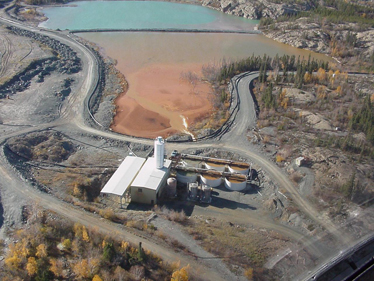Treating the water at Giant Mine
Managing water is an important part of the Giant Mine Remediation Project, both now and in the future.
On this page:
How the project currently treats water

The Giant Mine Remediation Project (the project) collects all water that enters the underground mine so it can be treated. This contaminated water is pumped to the surface, where it is temporarily stored in 1 of 4 site tailings ponds, known as the Northwest Pond. This tailings pond is large enough to store the water pumped from the underground mine throughout the year. During the spring and summer, the project pumps the water in Northwest Pond to an on-site effluent treatment plant. The treatment plant reduces the concentrations of arsenic and other contaminants of concern to levels below the limits identified in:
- the Project's Type A Water Licence issued by the Mackenzie Valley Land and Water Board
- the Metal and Diamond Mining Effluent Regulations
During the treatment process, water goes into the Settling Pond, where most of the remaining contaminants settle to the bottom and form a sludge. The water then passes into the Polishing Pond, while the contaminants stay at the bottom of the Settling Pond. This treatment process helps reduce the contaminants released into the environment.
Before being seasonally discharged into Baker Creek, the project tests the water to ensure it meets the effluent quality criteria outlined in the project's Type A Water Licence and limits in the Metal and Diamond Mining Effluent Regulations.
Giant Mine's treated water does not enter Yellowknife's water supply in the Yellowknife River. The treated water is released into Baker Creek. Though City of Yellowknife testing may show trace amounts of arsenic in the drinking water, these concentrations are well below the Guidelines for Canadian Drinking Water Quality. They are similar to levels found in many other communities such as Gamètì, Edmonton, and Toronto. Arsenic is naturally-occurring in the area and commonly found in the water of many rivers and lakes, including the Yellowknife River.
As outlined in the Closure and Reclamation Plan, the project will build a new water treatment plant. Once the new water treatment plant is operating, the Settling and Polishing Ponds will no longer be needed for the treatment process. They will be capped as part of remediation activities to prevent any remaining contamination from getting into the environment. The new water treatment plant will not need to store water in the Northwest Pond. Instead, it will draw directly from the underground minewater pool. The new water treatment plant will operate year-round.
Future water treatment
When the project's new water treatment plant is constructed and operating, it will treat water to meet the federal Guidelines for Canadian Drinking Water Quality for arsenic, as well as the limits in the Water Licence and Metal and Diamond Mining Effluent Regulations. The drinking water quality guideline is 10 micrograms of arsenic per litre. This directly responds to the Yellowknives Dene First Nation's requests that discharged water meet drinking water standards for arsenic. It also addresses concerns about potential locations for a new City of Yellowknife drinking water intake. Also, the new discharge will not use a diffuser, but instead will be a near-shore outfall, which is a discharge point for treated water. This will address concerns about ice thickness in Back Bay. Further details on this treatment method is available on the Mackenzie Valley Environmental Impact Review Board's public registry.
The new water treatment plant will be constructed to achieve the standard as outlined above and is slated for commissioning in 2025. The project team held engagement sessions in the fall of 2016 to gather input on potential outfall locations for the new plant. Discussions focused on:
- where the rights holders and stakeholders would like to see the outfall located
- the impacts of the outfall
- what the design could potentially look like
The project team used input from these sessions to identify outfall location options, based on this input, the Project team decided to build the outfall near the outlet of Baker Creek, beyond the shore of the townsite area in Yellowknife Bay.
Over the long-term, the project will operate the new water treatment plant in perpetuity, to keep water levels in the mine well below the workings that contain arsenic trioxide.
"Page details"
- Date modified: